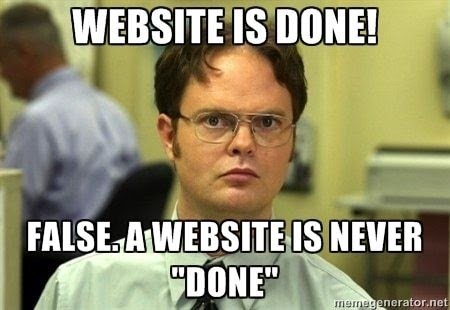Top Website Design Trends to Watch in 2025
As we move into 2025, the world of website design continues to evolve rapidly. Keeping your website modern, functional, and engaging isn’t just a matter of aesthetics—it’s crucial for staying competitive in an increasingly digital marketplace. Last week, we explored the pros and cons of Squarespace vs. WordPress, two popular platforms for building websites. This week, we’re diving into the latest design trends shaping the web and how you can implement them, no matter which platform you use.
Whether you’re refreshing your current site or building one from scratch, these trends can help you create a visually stunning, user-friendly experience that drives results.
1. Minimalist Design: Less Is More
In 2025, simplicity reigns supreme. Minimalist design focuses on clean layouts, plenty of white space, and uncluttered elements to create a calming and intuitive user experience.
Why It Matters:
Improved load times: Fewer design elements mean faster page speeds, which is essential for SEO and user retention.
Enhanced focus: A minimalist approach draws attention to key messages, calls-to-action (CTAs), and products without overwhelming visitors.
How to Implement It:
Use whitespace strategically to make content stand out.
Choose a simple color palette—two to three main colors are often enough.
Eliminate unnecessary graphics and focus on clear, high-quality images.
2. Dark Mode Is Here to Stay
Dark mode has been trending for a few years, and it’s not going anywhere in 2025. With its sleek, modern look and practical benefits, it’s a design choice that appeals to a wide audience.
Why It Matters:
Better readability: Reduces eye strain, especially in low-light environments.
Energy efficiency: Darker colors consume less power on OLED and AMOLED screens.
Aesthetic appeal: Creates a high-contrast, modern design that resonates with users.
How to Implement It:
Offer a dark mode option alongside the default light mode.
Use bold colors or gradients to make key elements pop against the dark background.
3. Interactive Features and Micro-Animations
Interactive websites that engage users through small, meaningful animations and features are gaining traction. These elements enhance user experience by making websites feel more dynamic and alive.
Why It Matters:
Increased engagement: Users are more likely to stay on a site that feels interactive.
Improved storytelling: Animations can guide users through your content in an intuitive way.
How to Implement It:
Add hover effects on buttons and links.
Use scroll-triggered animations to reveal content gradually.
Include interactive infographics or quizzes to encourage user participation.
4. Personalization: Tailoring Experiences to Users
With advancements in AI and analytics, personalized website experiences are becoming the norm. In 2025, customers expect content and features tailored to their preferences.
Why It Matters:
Higher conversion rates: Personalization leads to better user experiences and more conversions.
Stronger customer loyalty: Users feel valued when content resonates with their needs.
How to Implement It:
Use dynamic content based on user behavior or location.
Integrate personalized CTAs, such as “Welcome back, [Name]!”
Leverage AI-driven tools to recommend products or services based on browsing history.
5. AI-Powered Chatbots
Chatbots have moved from novelty to necessity. In 2025, they’re smarter and more capable than ever, helping businesses provide real-time support while collecting valuable insights.
Why It Matters:
Improved customer service: Instant responses keep users engaged and reduce frustration.
Time-saving: Automates FAQs and basic inquiries, freeing up your team for more complex tasks.
How to Implement It:
Integrate AI-powered chatbots like Drift or Tidio.
Use conversational tones to make interactions feel human.
Ensure the chatbot is mobile-optimized for seamless performance.
6. Seamless E-Commerce Integration
As online shopping continues to grow, having seamless e-commerce functionality is essential for business success in 2025.
Why It Matters:
Enhanced user experience: Easy navigation, clear product descriptions, and simple checkout processes lead to higher sales.
Mobile optimization: With more users shopping on mobile, seamless integration across devices is crucial.
How to Implement It:
Integrate user-friendly payment options like Apple Pay, Google Pay, and PayPal.
Optimize product pages with detailed descriptions and high-quality images.
Use abandoned cart emails to recapture lost sales.
7. Advanced SEO Features
No matter how stunning your website looks, it needs to be discoverable. In 2025, advanced SEO practices are essential for driving organic traffic.
Why It Matters:
Higher visibility: Good SEO ensures your site appears on the first page of search results.
Increased traffic: More visibility equals more potential customers.
How to Implement It:
Optimize for voice search by using long-tail keywords.
Create high-quality, keyword-rich content that answers user queries.
Leverage tools like Google Analytics and Search Console to monitor performance.
Why Keeping Up with Trends Matters
Web design trends evolve to meet the ever-changing expectations of users and search engines. Falling behind can make your business look outdated, reduce user engagement, and hurt your SEO rankings. By staying current, you can create a website that not only looks great but also delivers measurable results.
At Magnolia Marketing, we stay ahead of the curve to ensure your website is modern, functional, and optimized for success—whether you’re on Squarespace, WordPress, or another platform. Let’s turn these 2025 design trends into your competitive advantage!
Ready to Upgrade Your Website for 2025?
Contact Magnolia Marketing today for a free consultation and let’s build a website that works for your business.
